The blog went live last week, but since every day is Earth Day around here, I’m sharing it with you now. Read on for some great tips from sustainability bloggers around the web, including yours truly.
P.S. most of these tips are relevant for everyone, even if you don’t live in an apartment, so don’t let the title fool you into skipping this great read.
Switching to greener alternatives is a great way to live a sustainable life, especially with Earth Day approaching. There are many ways to be environmentally cautious while living in an apartment.
Most apartment complexes offer compost and recycling bins and there are many alternatives to things you use every day. To help you get started, we reached out to green experts to share their tips on how to live a sustainable lifestyle in an apartment. So whether you’re trying to live a more environmentally friendly life in your apartment in Boulder, CO, or your studio in New York, NY, read on to see what they had to say.
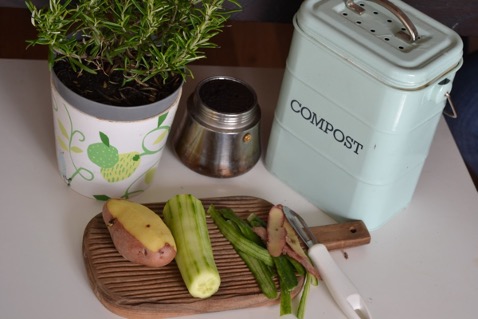
1) Ways to recycle when your apartment doesn’t offer the service
About 20 billion plastic water bottles wind up in landfills each year or are incinerated. Recycling those plastic bottles and aluminum cans helps the environment, and in some states like California, put some cashback in your pocket. Some apartment complexes don’t have separate recycling available for the residents so recyclable items end up in the trash and ultimately, in the landfills. Here are a few ways to recycle if your apartment complex doesn’t offer to recycle.
- Contact companies to pick up your cans and bottles from your door.
- Walk your recyclables down separately if your building has a designated recycling room.
- Ask friends who have access to curbside recycling if you could bring the recycling with them.
- Bring your recycling to a drop point or recycling center.
- Ask your landlord to get curbside recycling or set up a recycling area and get signatures from other people in your building.
- Bring it to work and use the office recycling pick up.
2) Be conscientious of where you live
Transportation has a big environmental impact, so choosing where to live can be a really important moment in your sustainability journey; it’s your opportunity to design a life where you can walk and bike more and drive less. Here’s a fun exercise I like to use when shopping for a new house or apartment:
- Grab a map and draw dots on the map to mark the places you need to visit often (for example, your work, the kids’ schools, your favorite grocery stores, restaurants, coffee shops, the public library – whatever is most important to you). Hopefully, these are clustered in one area of the map. If not, start with the most important cluster and repeat this exercise multiple times.
- Use a string and a pencil to draw two circles, with your cluster of dots at the center; one that represents 1 mile and another that represents 3 miles; you should, of course, choose distances that feel right to you and your walking/biking lifestyle. If public transportation is an option, draw a third circle to represent your reasonable commute on public transportation.
- These circles represent the best areas for you to live. If you had to do this for multiple clusters, look for overlapping circles that will allow you to live in one place, yet walk, bike, or take public transportation to your most important/frequent destinations.
3) Planning is a crucial part of a sustainable lifestyle
There are so many fantastic tips for reducing food waste from adding kitchen rolls to your bags of salad leaves extending their freshness by up to 4 days to keeping your spring onions in a glass of water and placing them near your kitchen window – this allows you to clip them as you need them and have them grow back in between. But the most important thing is ‘Planning’, plan your meals for the week in advance of going shopping. Then check what food you currently have and after that only buy what you need for the planned meals. Lastly, the freezer is your friend. If you have too much food, freeze it instead of letting it go to waste. – Foodie Save
4) Composting companies can aid you on your journey
Managing your own composting system in an apartment can be difficult. Some companies provide a 5-gallon bucket with an easy-to-remove, but tight sealing lid for you to store your food scraps, and can even empty it for you. – Circle Compost
5) Simple switches can make a big difference
We believe you don’t have to switch up your entire life to live more sustainably in an apartment. Simple swaps like replacing your shower head for a water-saving version, switching out your soap products for low/zero waste alternatives, or starting a worm composting bin on your patio for your food waste can all make apartment living a little greener. By being informed consumers and utilizing our purchasing power in sustainable ways, we can co-create a healthier, more abundant planet. – Heal the Planet

6) Use reusable food wraps to preserve leftovers
Use reusable food wraps for long-lasting produce. Learn veggie revival tips, recipes that preserve or celebrate seasonal favorites, and how to cultivate a scrappy kitchen ecosystem that alchemizes trash into treasure – like turning a freezer full of peels into stock, excess herbs into pesto, leftover berries, and kale into smoothie cubes, the last of this-n-that into salad dressing. Whatever your imagination dreams up to rise to the challenge of no leaf left behind. – Z Wraps
7) Be mindful of your surroundings and ‘unplug’
We believe living a more sustainable life means being more aware of the entire energy ecosystem around you, and making little decisions that can have a big impact. This can be as simple as ‘unplugging’ literally and figuratively. For example, designate a special time of each day (or week) and commit to shutting off smartphones, computers, and the TV to enjoy some low-tech time out. Shutting down over time adds up. Chargers, even without being attached to a phone or device, still draw between 0.1 and 0.5 watts per hour. – Pink Energy
8) Keep your compost and plants bug-free
We understand that keeping things sustainable and hassle-free isn’t always easy, so take advantage of their simple sustainable solutions to common problems: Pest products can tackle fruit flies for those kitchen composters out there. – Aunt Fannie’s
9) Switch to eco-friendly kitchen accessories
Each of us has a moral responsibility to be environmentally friendly by reducing waste and conserving our planet’s precious resources. One simple solution is to get rid of the single-use plastic products and switch to compostable products in your kitchen. You can start by using eco-friendly dinnerware such as plant-based cups, plates, straws, and cutlery composting help break down organic materials and turn them into rich soil, without harming the environment with chemicals or filling up the landfills. – Greenchain Compostables
10) See if your building provides EV charging equipment
Your apartment is a reflection of you, like your commitment to a sustainable lifestyle and your decision to drive an electric vehicle. Make a statement by living where that commitment is shared by your fellow residents and building owners too. Look for EV charging equipment and talk to the building management about valuable utility incentives and potential carbon credits for adding charging. – Tracy K. Price, CEO of Qmerit.
11) Reduce your plastic waste with biodegradable bags
We feel one of the best ways to live a sustainable apartment life is to reduce your plastic waste by looking for re-usable plastic products or non-plastic products, recycle what can’t be reused, look for products with the least amount of wasteful packaging, and supporting companies with a sustainable environmental mission. And when you do throw away garbage use biodegradable bags. – BagUps
12) Be an eco-conscious consumer
Limited space in apartment living can be a real struggle. For anyone pursuing a sustainable lifestyle, my advice is to adopt the mindset of an eco-conscious consumer. This mindset begins by minimizing your possessions. It’s easier to get organized when you get back to the basics, plus life gets simpler. You would be amazed how uncluttered the mind can become just by decluttering the physical space surrounding you. Next, when shopping and acquiring new possessions, commit to donating one or two items for every new thing you bring into your space. This mindset will help you choose quality over quantity and think before buying. – ECO CRATES of America
13) Support renewable energy
Whether you rent or own an apartment, anyone can easily reduce their carbon footprint by supporting renewable energy from sources that replenish themselves naturally — like wind, water, sun, or forests. There can be affordable ways to reduce your environmental impact. In states like Maine, you are able to support renewable energy by matching your electricity use with no-emission 100% Maine-made clean energy. – Maine Green Power
Which of these is most eye-opening for you? Is one of your favorite tips missing from the list? Share your feedback in the comments!
]]>
There’s one thing I know for certain: we can’t consume our way to a life that doesn’t destroy the planet, so you won’t find a quick list of things to buy in any of my blog posts. That means my top five is a list of simple ways to change your mindset and habits that will help you tread lightly on the planet. So… after a couple weeks of thoughtful reflection, here’s my list of five great sustainability {mindset} swaps (in order of importance, according to me, which means they’re based on science and anecdotal lessons learned from friends and clients):

1. Drive less, walk or bike more. Take a good hard look at your car before you drive somewhere. Can you walk your kids to school instead of driving them? Can you walk or bike to the grocery store? If your gut reflex is no, I encourage you to think a little more creatively… a backpack is great for carrying groceries home on foot and a bike trailer is your friend when you’re biking. These activities will reduce your impact on the earth (mostly carbon emissions, which are causing global warming) AND make you healthier! Sure, it might take you a little longer than driving, but can you eliminate time at the gym because you’re so much more active during the day? This is an important swap in your daily life and especially important when you’re making big life decisions, like taking a new job or buying a new house. In those big moments, consider driving vs walking/biking as an important factor in your decision.
2. Keep looking at your car and calculate your miles per gallon (mpg) efficiency, if you don’t already know it. This tells you how efficient your engine is at driving you where you need to go per gallon of gas it burns. You want this number to be as high as possible. For example, the average truck, minivan or SUV gets about 17.5 miles per gallon of gas. An average car gets closer to 25 mpg and a motorcycle gets around 45 mpg (the source for all of these numbers is here). When you’re ready to replace your car, buy the most efficient car you can afford (that’s one with the highest mpg rating). I’m a huge fan of electric vehicles (EVs) and purchased a Tesla Model S in February 2020. You can read about my experience in blogs here and here. If you want to talk more about EVs, please leave your questions and comments below!
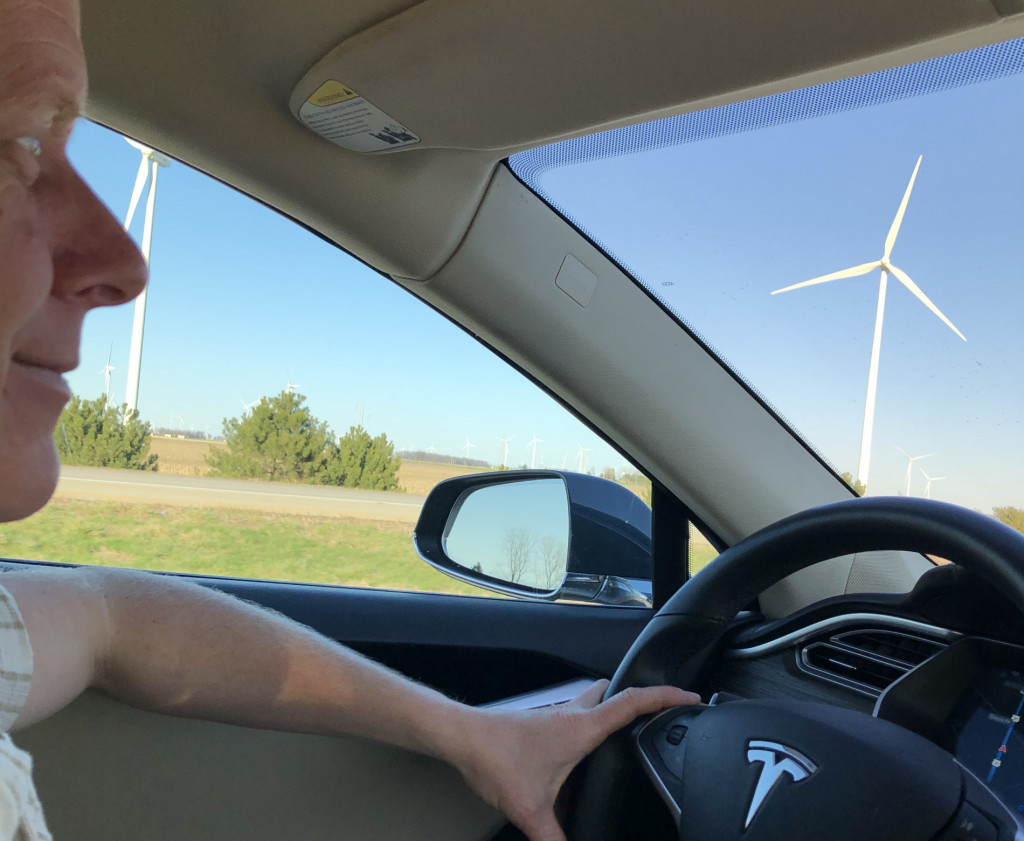
3. While we’re talking about electricity, do you know where yours comes from? Electricity in the US is generated, on average, from the following resources (all of the following info is from US Energy Information Administration (EIA) which has a lot of great resources if you want to learn more):
- 40% natural gas
- 19% coal
- 20% nuclear
- 20% renewables (like wind, solar, and hydro)
- 1% petroleum
If you want to get more specific to your state or electrical grid, you can learn more here (it’s another great page on the EIA website). Learning more about electricity is great, but my recommended action here is to call your electric utility company and request 100% renewable electricity. Most utilities have a program that lets you pay a little extra (for reference, my monthly bill increased $10 when I made the switch) for 100% renewable electricity. I know… you have lots of questions… like “how can I just buy renewables? Am I actually getting renewable electricity delivered to my house???”
The short answer is this: when you subscribe to green electricity programs like this you’re incentivizing your local utility to invest in more renewable electricity projects. This means they’ll build more solar arrays or install more wind turbines. You’re really buying a renewable electricity credits, which means that an equal amount of “extra” green electricity is being produced on your behalf. No, the utility can’t send this electricity directly to your house, but you are part of the overall move to a greener and more renewable electricity grid and you are voting with your dollars every single month. Still have questions? Drop them in the comments below and I’ll help you find the answer!
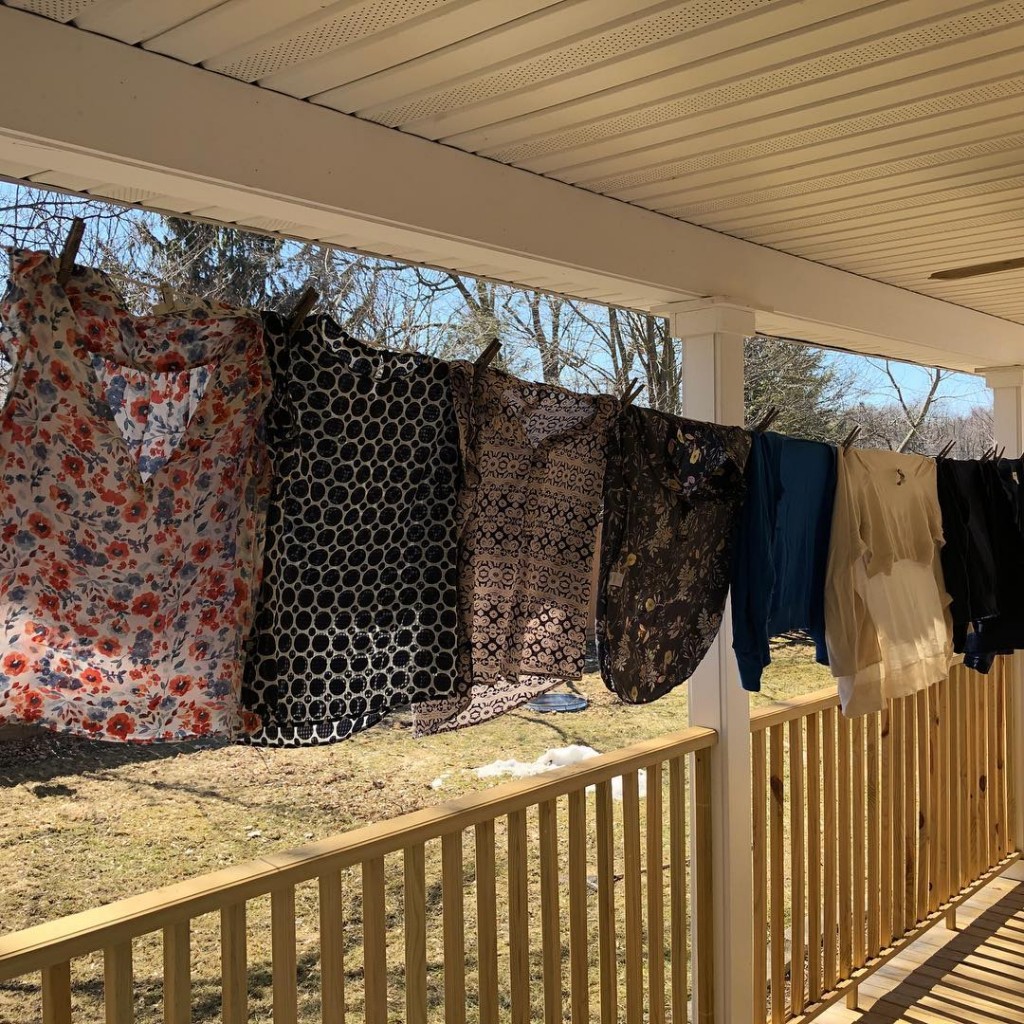
4. Embrace minimalism. Do you really need all the stuff in your life? Does it really make you happier? For me, minimalism is a great mindset to truly embrace the Reduce in the decades old mantra “Reduce. Reuse. Recycle.” Yes, recycling is important and you should do that too, but moving beyond recycling and buying less stuff is where the magic happens when trying not to destroy the planet.
Think about it this way: every single thing you own was created from the Earth’s precious resources. These resources were mined, grown or harvested from somewhere, transported to a processing site where they were turned from the raw material into a more usable form, transported to another manufacturing site where they were combined into the thing in your hands, transported to a store or warehouse, and then transported again to you. And that’s probably an oversimplified version of the truth. This happens over and over again for every single object in our lives. With this in mind, I ask again… Do you really need all the stuff in your life? What could you choose to live without? What would actually make you happier NOT to own?
If you’re ready to embrace minimalism, there are TONS of resources out there for you to explore, but some of my favorites include: The Minimalists blog, the book Soulful Simplicity by Courtney Carver, and the Our Minimalist Lifestyle Facebook Group. Please share your favorite resources in the comments!

5. Stop wasting food. Each year, the average American throws away more than 200 pounds of food at a cost of more than $1,600 per family! And if food waste were a country, it would be the third largest emitter of greenhouse gases (GHGs, the major cause of climate change), behind the Unites States and China. Farming of meat animals and food transportation are additional contributors of GHG emissions, so I’ll give bonus points for eating less meat and more local food.
There are lots of great strategies you can use to reduce food waste in your home. Some of my favorites include
- create a weekly meal plan
- buy less during each trip to the grocery store
- organize your food storage areas (fridge, pantry, freezer) so you can find your food easier
- learn about best by, use by, and other perishable food labels to avoid spoilage
- freeze leftovers and other perishable items before their expiration date
Here they are, all together once more:
- Drive less, walk and bike more
- Buy the most efficient car you can afford
- Buy renewable electricity
- Embrace minimalism
- Stop wasting food
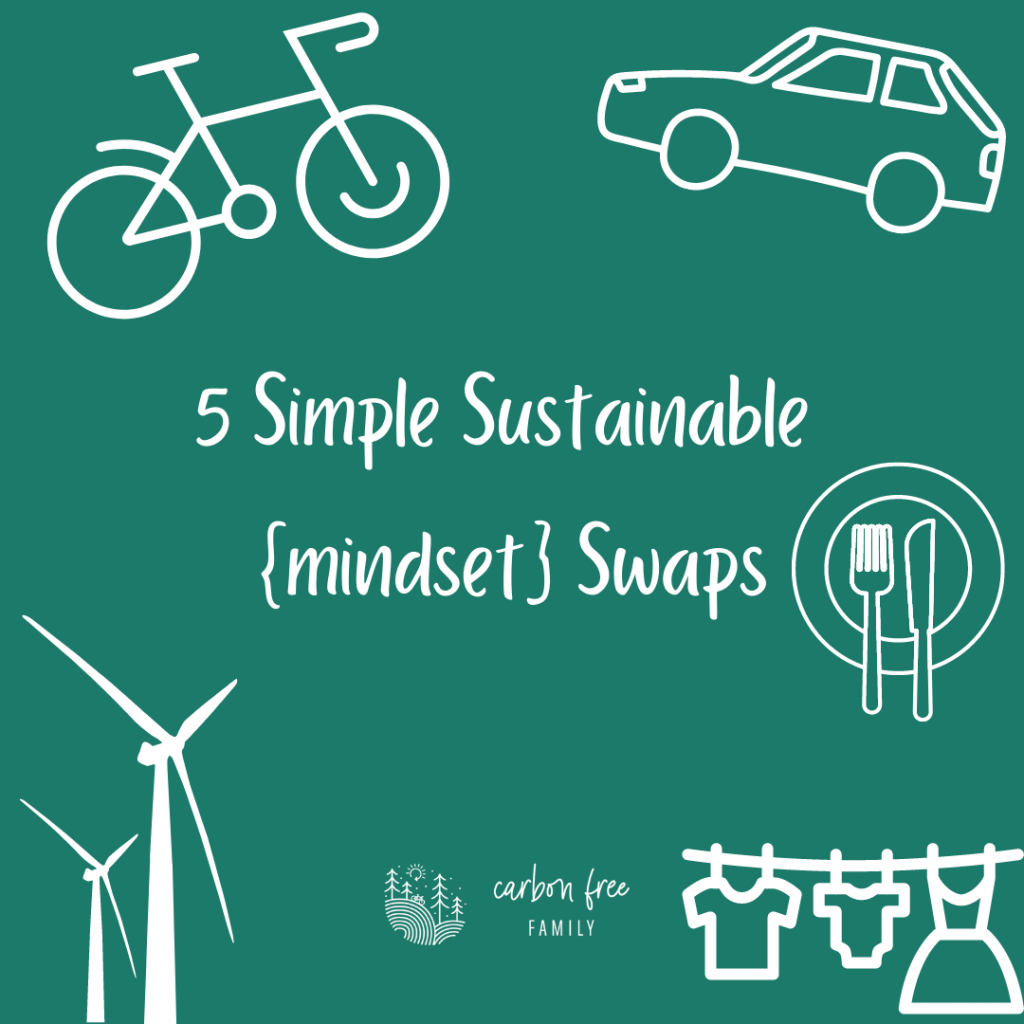
Do some or all of these recommended {mindset} swaps resonate with you? Share your thoughts and experiences in the comments!
Looking for more? If you’ve already made these swaps and are ready to make deeper change, I highly recommend calculating your ecological footprint and using the results to identify your biggest opportunities.
]]>
I should start by telling you that our daily life is not designed around a car, not any car. I bike my 1.6 mile commute to work, every single day (yes, even in winter… just for fun, I’ve included a photo of my winter bike below). And Robbie stays home with the kids so he doesn’t have a daily commute to work. Our oldest daughter walks to school. Robbie and our youngest daughter have designed their daily life around walkable and bikeable destinations. I’m forever grateful for the fantastic walkability and bikeability of our sweet little town of Rockford, MI. We drive 20 minutes for groceries (not more than once per week) and about an hour to visit close family + friends (again, not more than once per week). So our routine car use is pretty much a perfect fit for an electric vehicle.
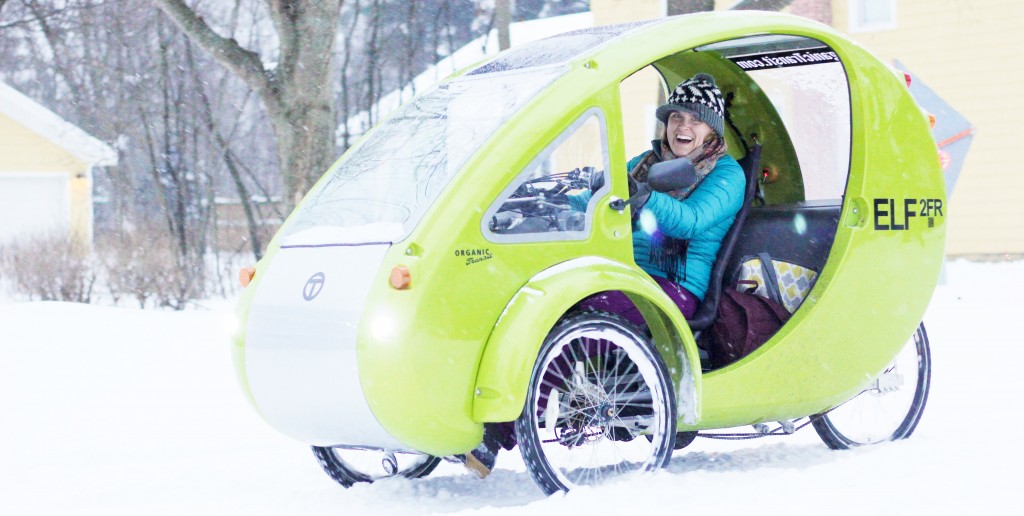
Let’s pivot to our Big Concern. Road trips. Full disclosure: I’m the worst roadtripper. Ever. More than a few hours and I turn into a whiny puddle of jelly in the front seat, asking “are we there yet?” more often than the children! So while this was our biggest concern, it still wasn’t that big of a deal because we usually fly somewhere far away or focus on finding adventure relatively close to home. Fast forward a few months after we bought the car… and here we are in the middle of a global pandemic and nobody’s flying, nowhere fast.
So, Spring Break 2021 was a family road trip to the Smoky Mountains National Park. We had a few major goals for this road trip:
- Drive the approximately 700 miles to our spring break destination
- HAVE FUN! (if you’re new to Carbon Free Family, you’ll quickly learn that this is always our top priority. We firmly believe that a more sustainable life can be fun!)
- Become more comfortable with charging our car while driving longer distances
- Arrive at our destination at or near the perfect check-in time at our AirBnB
We planned to take 2 days to drive the 700 miles from Rockford, Michigan to Hot Springs, NC and this trip went remarkably according to plan. The only planning I did ahead of time was to book our overnight hotel in Cincinnati. I picked the hotel specifically because they had two Tesla destination charging stations (I explain the difference between a supercharger and a destination charger in this FAQ blog). I was very pleased to learn that Marriott hotels lists electric charging stations in the “parking and transit” section of their hotel descriptions. I wish the brand would go one step further and include this in the “filters” so I can search specifically for hotels with charging stations (nudge, nudge @Marriott).

Away we go! Here’s what our first day looked like:
(you can follow along as if this were in real time in the “tesla EV” highlight on my Instagram)
2:15pm: Rockford, MI
We left the house at around 2:15pm with an 80% charge (237 miles). We weren’t at 100% because my daughter and I drove to our horse barn in the morning to sneak in a quick lesson before leaving for vacation. Ideally, we would leave the house with a full charge for a road trip like this, but life is all about compromise, right?
3:45pm:
We stopped for a potty break at 3:45pm. We didn’t need to charge yet, but… little bladders couldn’t hold it for 30 minutes to make it to the supercharger. Someday soon I’m certain there will be a EV charging station at every rest area and even our 15 minute potty break would recharge our battery a smidge.
4:30pm: Angola, MI
We stopped for our first charge of the trip in Angola, IN. We had about 55 miles of range left, so it was a pretty long charge. This was not my favorite charging station of the trip… slow speeds (only about 190 mi/hr or 55kW) and almost no amenities. Especially since we needed a big charge, I would have preferred a faster speed charger (you’ll see that sometimes we can get up to 400 miles/hour… this measurement is telling you the number of miles of charge gained by the battery per hour of charging). We stayed for about 45 minutes and left with 182 miles of range.
We like to plan our meals around charging stops, either popping into a grocery store to buy picnic supplies or ordering takeout from a nearby restaurant. In Angola, the charging station (a bank of 6 units) was located in an isolated strip mall with a motel and really small diner style restaurant. Maybe another time we’ll try the food, but this time we opted for soccer in the beautiful green space nearby. I would rate this stop 1/10 on speed and amenities, but 10/10 on green space. Check out the beautiful trail and field to play in!
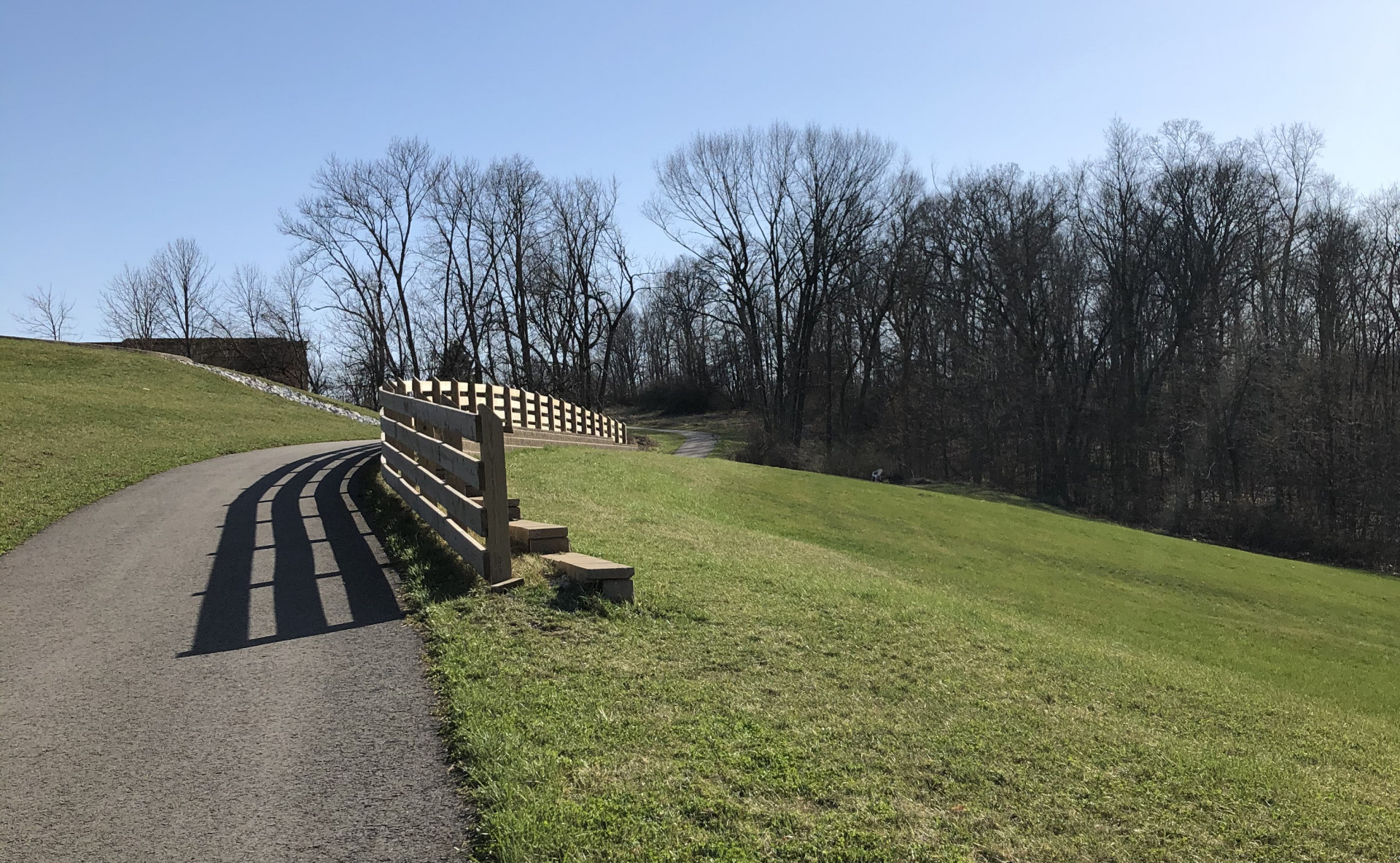
7:30pm: Lima, OH
We arrived with about 60 miles of range and were excited to find 8 spaces, only one other car, and fast charging speeds (between 320 and 350 mi/hr). This station was located in a very commercial area, with several hotels, restaurants, and not much green space. We walked through parking lots (no sidewalks… I should probably save it for another time, but I think there’s a real opportunity for areas near a charging station to be better designed for walkability) to a Panera Bread for snacks (for the kids) and a {decaf} cappuccino (for me) and to stretch our legs. Robbie played soccer with the kids in the hotel parking lot as the sun began to set. It was really a lovely scene. We stayed just long enough to gain enough charge to complete the remaining 135 miles to the hotel, around 40 minutes.
10:30pm: Cincinnati, OH
We arrived at our hotel happy and ready for bed. It took us just over 8 hours to drive 385 miles on the first day of our road trip. This is probably about an hour and a half longer than if we were death marching (meaning nascar style pee breaks with no time for play) in a gas-powered car. We don’t travel that way anyways, so for us this feels like slightly longer than it would have taken us in our old {gas-powered} car, but not noticeably longer.
We stayed at a Marriott and they had two Tesla charging stations + another non-tesla charger. The charging speed was slow (about 25 miles per hour), but slower speeds are fine for an overnight stop. We left in the morning around 9am with a full charge (251 miles… even more than when we left our house the previous day!).
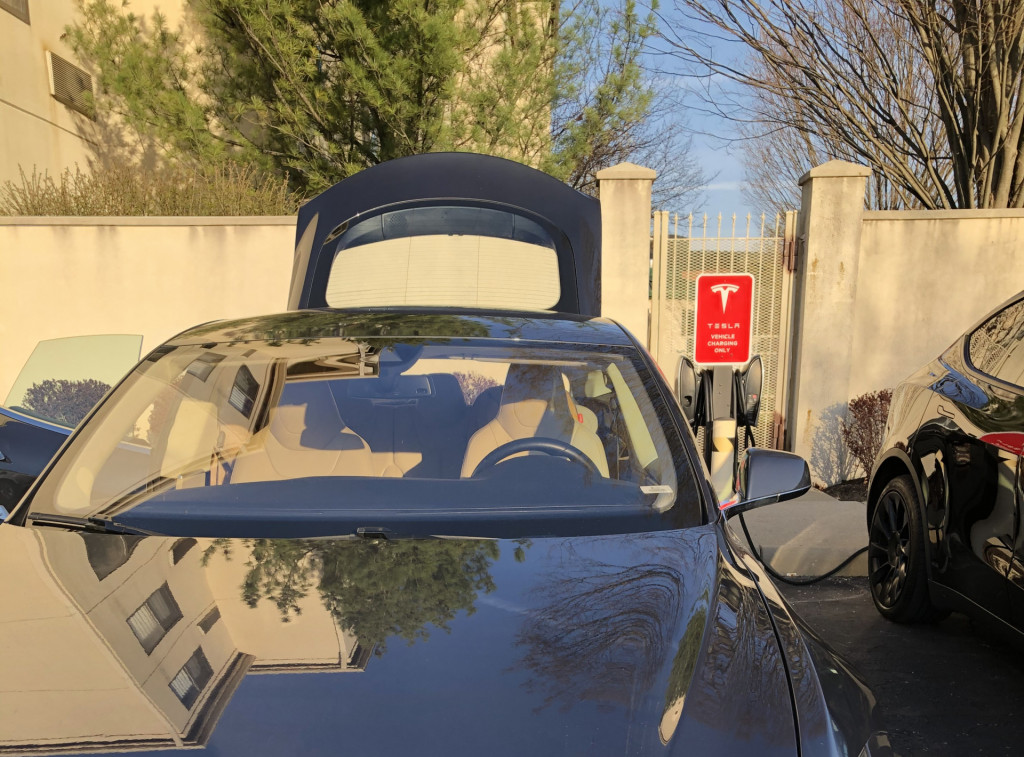
And we’re off again! Day 2 of our road trip:
9am: Cincinnati, OH
We only had 295 miles to go today and planned on making just one charging stop. We couldn’t check into our AirBnB until 3pm, so we took out time leaving the hotel.
11am: London, KY
This was the best charging stop of our trip! We knew we wanted to eat an early lunch, so I went online on my phone (from the highway) to look for a restaurant. There was a Cracker Barrel nearby so I placed an order online. Once we arrived, I took a nice little walk (again, no sidewalks though) to pick up our lunch while Robbie and the girls played soccer + set up a beautiful picnic space. This charging station had it all… green space to play, easily accessible bathrooms (in a tourist information center) and lots of restaurants to choose from. We took our time here and stayed about an hour, plenty of time for our car to completely charge up again.
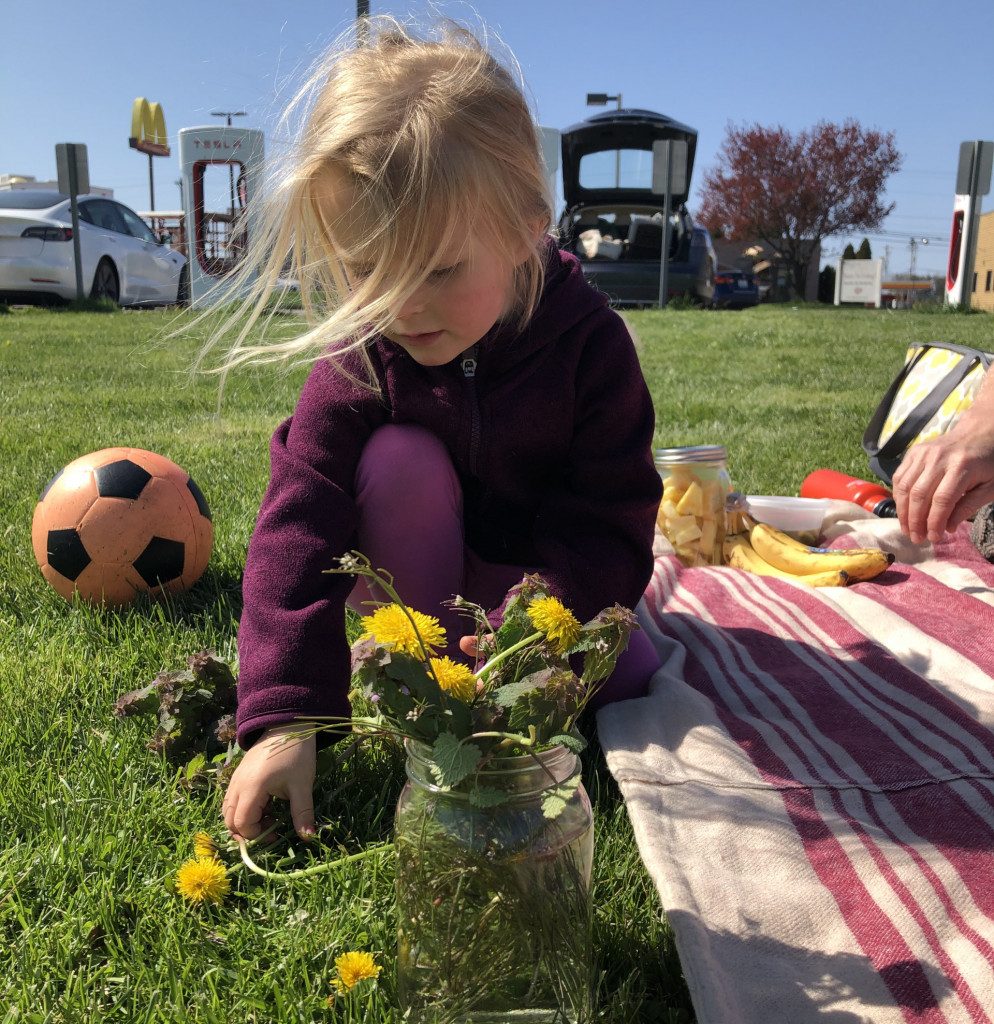
3pm: Hot Springs, NC
We arrived! Happy, healthy, relaxed, with plenty of charge left, and ready for a wonderful week in the North Carolina mountains!
But what about during vacation… I’ll admit that I didn’t really think about this when booking my family vacation in a tiny little town in the North Carolina mountains. We didn’t even ponder how we were going to recharge during the week until it magically popped into Robbie’s head a couple of days before we left. Thankfully, there was a charger in downtown Hot Springs, less than a half mile walk (on the Appalachian Trail, no less) from our rented home. Twice during the week, we used these charging stations at the Hot Springs Resort and Spa (and campground). These were destination chargers (again, see this FAQ blog for a full explanation of what this means) so they charged slowly, but we parked there overnight and it worked out just fine.
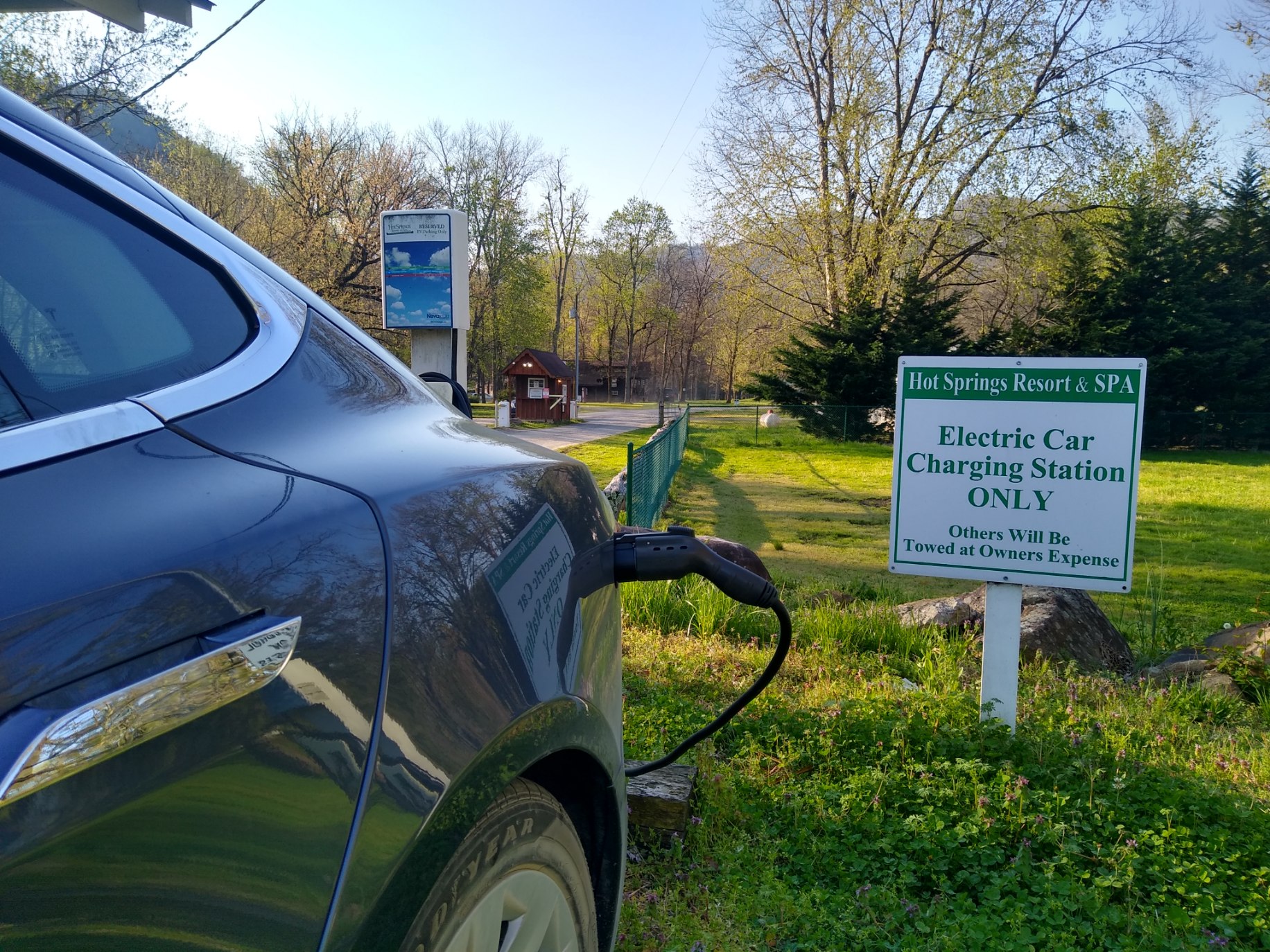
So what were my key takeaways from this first road trip in my new Tesla?
- It doesn’t take that much longer. In fact, pausing to recharge my car supports my intention to live a slower life. It encourages me to enjoy the little moments along the journey rather than racing to the destination.
- Plan ahead for food. Ordering on the road and having snacks in cases where food options are limited are both helpful strategies.
- Make sure there’s a charger at/near your vacation destination
Are you driving an electric car yet? If so, tell me about your charging adventures in the comments! If not, whats your biggest concern… what’s holding you back?
]]>
Q: Does your Tesla use any gasoline?
Nope. Not one drop. How crazy is that?!?!
In fact, I find it fascinating to think about all of the pieces of a car associated with the gas engine that we don’t have…
Radiator? Nope.
Exhaust System? Nope.
Oil changes? Never have to do those.
Q: Do you have to drive out of your way to find a charging station?
Not necessarily. One of the reasons we bought a Tesla was for the amazingly designed charging network. There’s a super charger within 100 miles of just about every location in the United States. Check out the map below (from Tesla).
In fact, on our recent road trip from Michigan to North Carolina, we drove less miles following the route with charging stations that we would have otherwise (approximately 630 miles vs 690 miles). It took longer (see this blog post for a full recap of the trip), yes, but the miles driven were less.
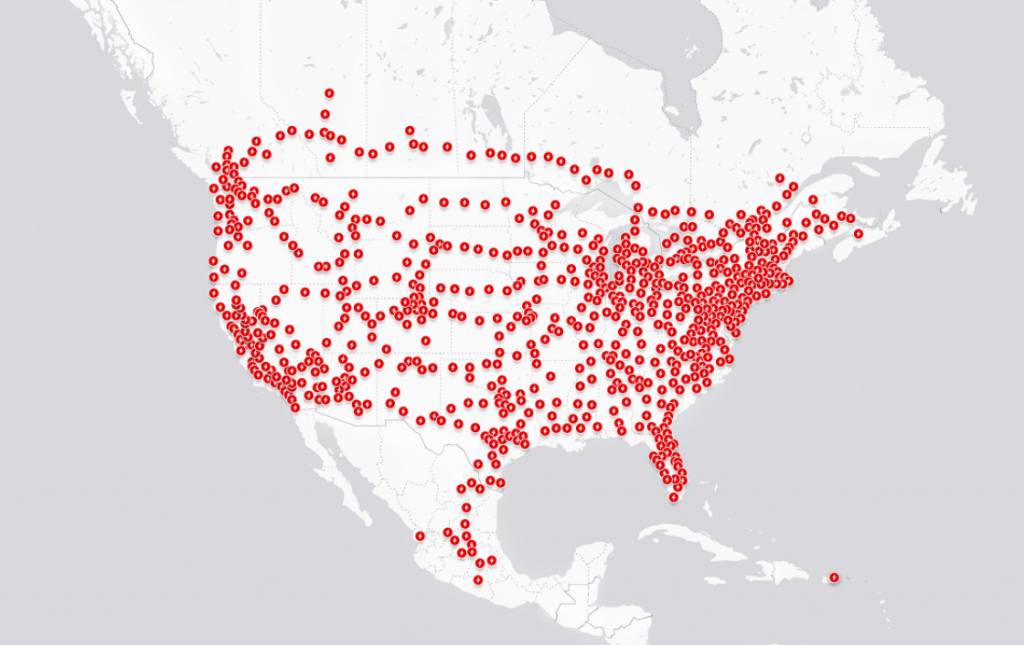
Q: What mapping software do you use to map your route with charging stations?
From my phone or computer, I generally use A Better Route Planner. Once I’m in the car, Tesla has a pretty good mapping system built into the dashboard and I usually use that. In both of these mapping tools, I enter my destination and the route automatically includes one or more stops at charging stations along my route to ensure I’ll arrive at my destination safely. These directions are optimized for route and charge time… meaning that often I will stop for two shorter charges rather than one longer one because charging efficiency is highest when your battery is low (battery low = fast charging; battery nearly full = slower charging speed).
Q: What’s the difference between a supercharger and a destination charger?
Tesla Superchargers are 480-volt chargers that are designed to charge a Tesla in under an hour, making them perfect for charging up on long-distance road trips. They’ve generally been installed in a grid across the country, strategically placed on highly traveled routes/roads. These are installed and owned by Tesla, in partnership with various local businesses and towns.
Destination chargers, on the other hand, are installed by businesses and land owners for public use. They have a slower charging speed than Superchargers, adding about 35 or 40 miles of range per hour of charging. This blog has lots more information about the charging network if you’re interested in reading more. Destination chargers are being installed all over the country and are often designed to charge both Teslas and other brands of electric vehicles at the same charging station. It’s worth noting that if you want to charge your Tesla at a non-tesla branded charger, you do need to carry a converter with you because the plugs are shaped differently.

Q: How much does it cost to charge? Is it cheaper than gas?
Some places (usually slower chargers at a destination, like a museum, zoo, or business) are free, but the Tesla supercharging network we usually chose to use charges, on average $0.25 per kilowatt (kW). My Model S can drive approximately 3 miles per kW, which means I’m paying about $0.08 per mile.
When I charge at home, my cost to charge is even less, as I pay about $0.10 per kW for my electricity at home, which equates to about $0.03 per mile.
For reference, lets compare that to my previous car (an ’08 Honda Fit that got approximately 35 mpg) and assume the current gas price of $2.63 per gallon. I was paying about $0.13 per mile, so operating my Tesla (even if I always have to charge at the “expensive” supercharging stations) is cheaper than operating my old gas engine car.
Now, my Honda Fit cost me approximately $17,000 to buy in 2008 and I paid about $50,000 for my used Tesla in 2020, so I’ll have to drive 660,000 miles before I make up the difference in purchase price. There are additional cost savings in maintenance (for example, I never have to change my oil). This blog estimates the average maintenance at around $300 per year.
Q: Electricity is made by burning fossil fuels, so how is an electric car better for the environment?
You’re right that lots of the electricity in the United States is made by coal burning power plants. According to the US Energy Information Administration (eia) about 60% of electricity generated in the US in 2020 was from fossil fuels—coal, natural gas, petroleum, and other gases. About 20% was from nuclear energy, and about 20% was from renewable energy sources.
At home, we purchase 100% renewable energy credits. While it’s impossible to received the exact kW generated from solar and wind because it all gets mixed together in the grid, when I choose to pay an extra $1.50 per 150 kWh, I’m encouraging Consumers Energy, our electricity provider, to invest in more renewables and helping to fund these projects. You can do this too, by joining the Solar Gardens program. Subscription levels start at $9 per month and help fund solar panel projects throughout the state.
Whether you have an electric car or not, I encourage you to contact your electricity provider and ask about their renewable energy programs. Programs throughout the country are all structured a little differently, but nearly every electricity company has one. And if yours doesn’t, keep pestering them until they create one. As their customer, you hold all the power (pun intended)!
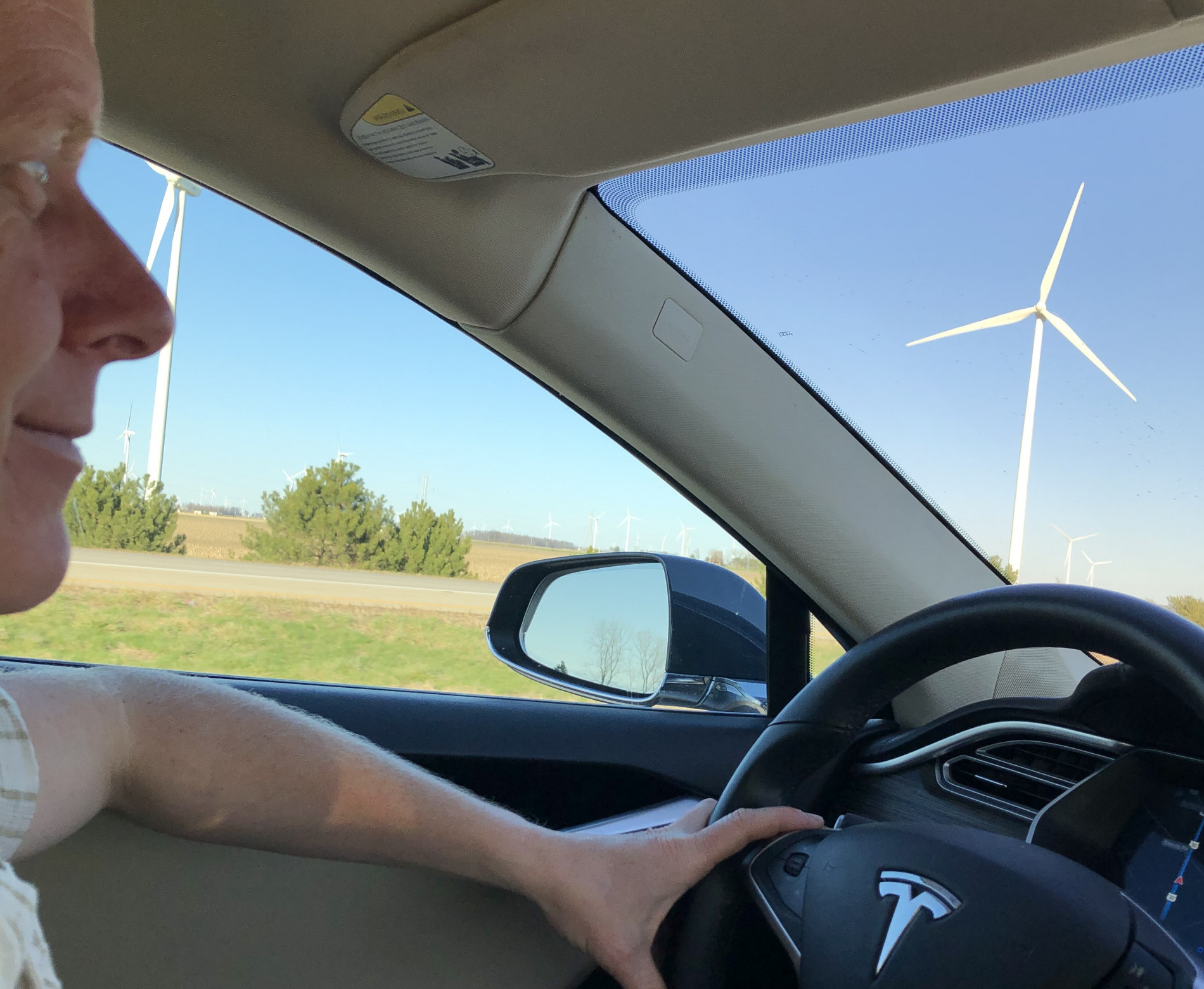
Do you have a question I didn’t answer yet?? Post your questions in the comments box below, message me on Facebook or Instagram or email me at carbonfreefamily@gmail.com.
]]>
My annual goal setting, much like my life, is a slow and reflective process. I like to calculate my environmental footprint (see my blog post last week for more information), reflect on last years’ progress and this year’s biggest opportunities.
I’m excited to take you on a journey of my 2021 intentions. I’ve organized them to coincide with the areas highlighted by the environmental footprint calculator and in order of my biggest to smallest opportunity to reduce my impacts: transportation, food, shelter, goods, and services.

Transportation remains my biggest opportunity. So, this year, I have the following goals:
- No flights – In 2020, we committed to no flights and found adventure nearby (see last week’s blog for more details). We explored our home state of Michigan and had wonderful family adventure (yes, even in the midst of the pandemic). I love travel, but I know how impactful my flights are. In 2021, we’re going to remain focused on nearby adventures, expanding our radius to include longer car rides this year… we’ve got a date with the smoky mountains for spring break! My long term solution will include offsetting the emissions from our family vacations, so please send me your recommendations if you’ve purchased offsets.
- Become a one car family again – In 2020, we bought a 100% electric vehicle (again, see last week’s blog for more details). We’ve been a one car family for several years, but it’s taken us months to fully embrace our new Tesla and be ready to give up our trusty old ‘08 Honda Fit. This is mostly because Robbie has dirty hobbies like hunting and woodworking and we had to figure out a way to haul messy things in our “fancy new car”. A few weeks ago, we installed a trailer hitch on the Tessy, so we’re finally ready to let Honda go and return to being a one car family. I can’t tell you how excited I am to never buy gasoline again!
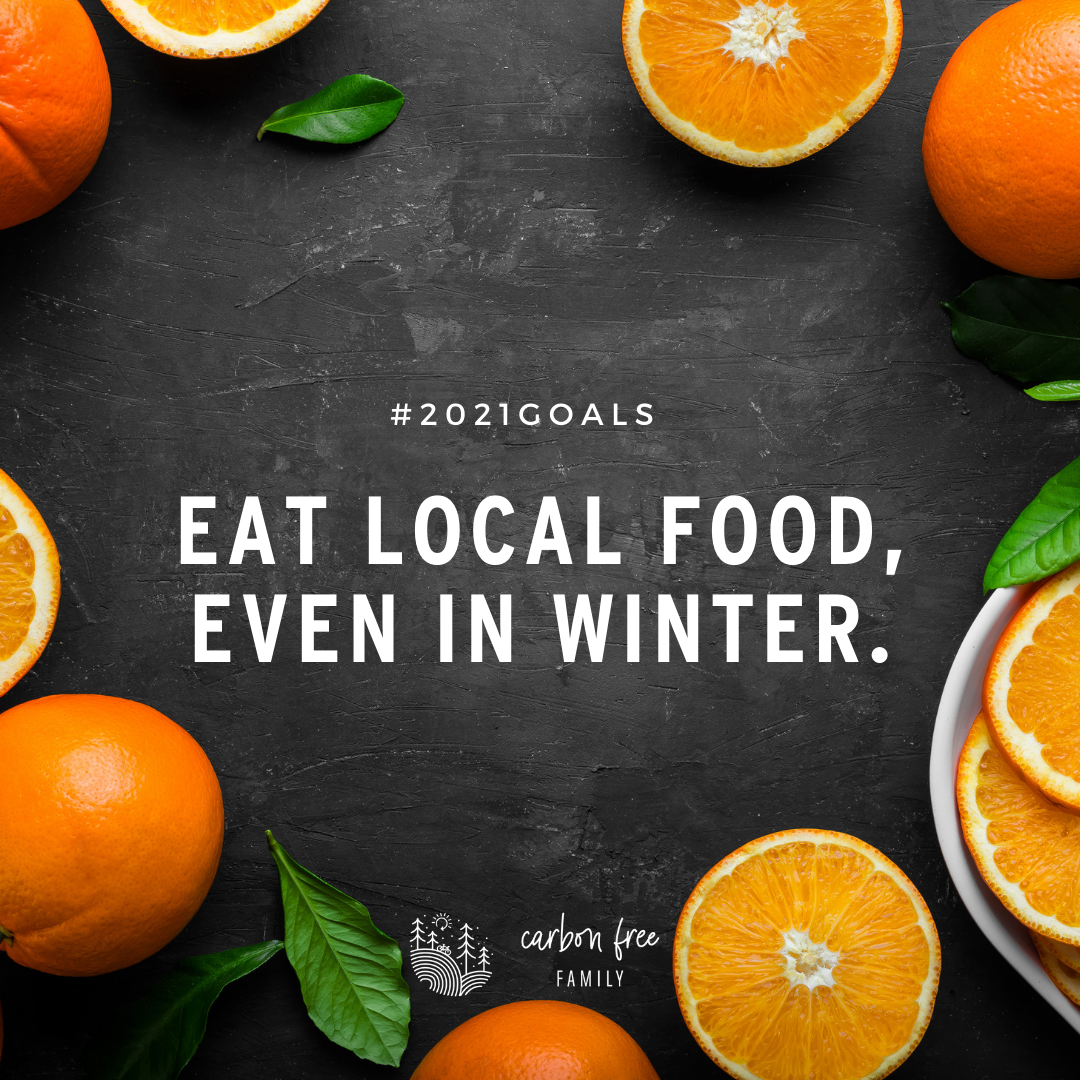
My food is wildly important to me as I work to fully align my life with my values. And it’s my second biggest opportunity to impact my footprint. I also find the food category to be a stubborn one… meaning, its hard to see the impact (via a lower environmental footprint in the calculator) from the changes I’ve made (one more time, see last week’s blog for more on this). But that’s not going to stop me from leaning in to the joyous parts of my food journey! This year, I have only one food-related goal:
Eat local food, even in winter.
I’m proud of my summertime foodprint (that is, the environmental footprint of my food), but during the winter in Michigan I struggle to find locally grown, unpackaged food. So, I’m going to focus on this goal especially hard in the next couple of months (February through May) until my own backyard vegetable starts to produce and my local farmers market starts up again.
Here’s where YOU can help!
Michigan friends – please comment below with your favorite winter farm shares, farmers markets, and other resources you have for local food (that are available right now!) so I can build a robust list of farmers to support during these cold winter months. I promise to explore your recommendations and share my adventure, with details and recommendations, in an upcoming blog post.
Non-Michigan friends – please share your strategies and recommendations too! I have followers all over the world and we can always learn from your strategies!
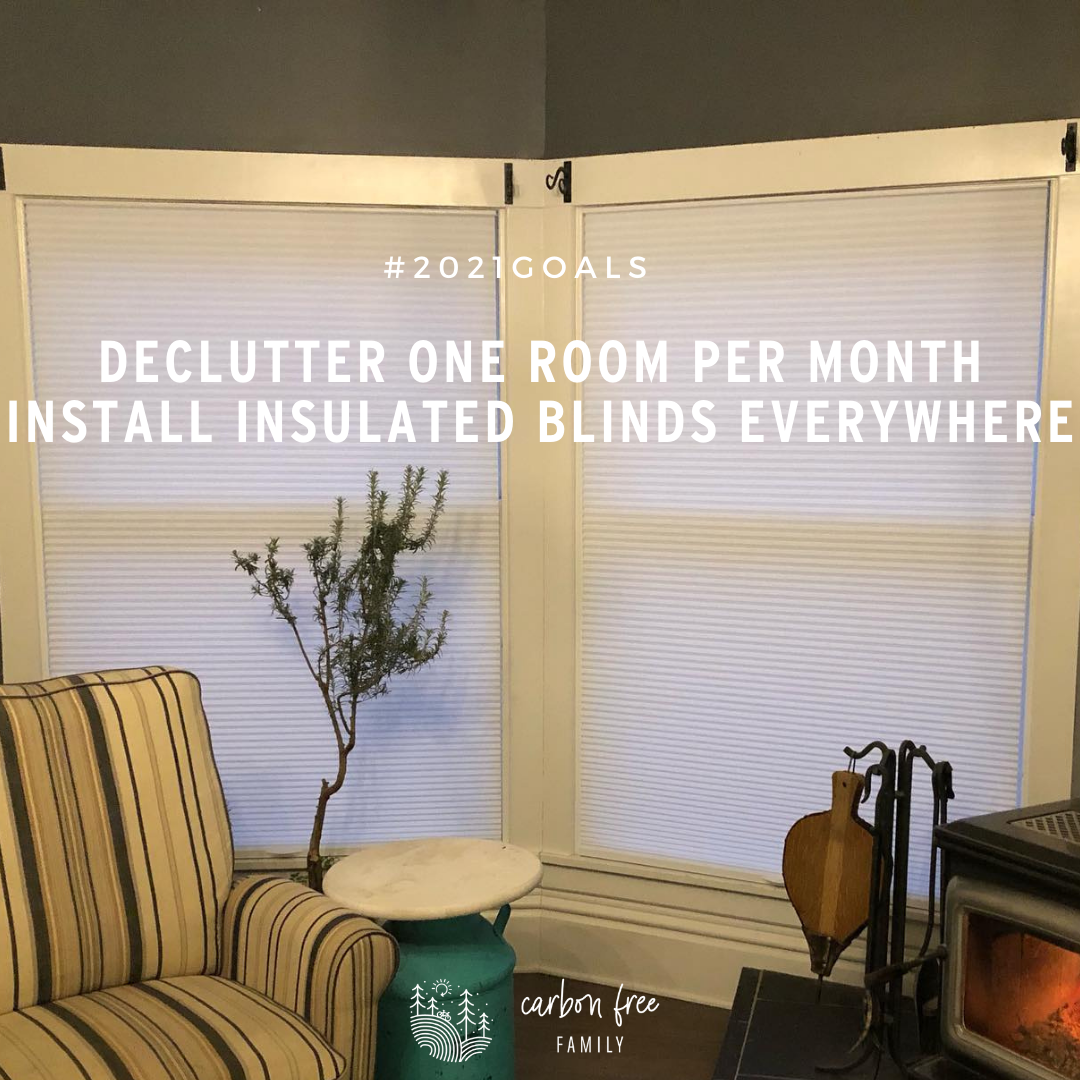
This year I’ve realized how very important it is for my home to be a place of peace, relaxation, and comfort. A place that calms my nerves, supports connected time with my family, and gives my soul space to Just Be Here. It’s not surprising that my 2021 goals include a few to make my home more cozy (and energy efficient) and less cluttered. I love it when the connections between minimalism and sustainability are clear like this.
- Declutter one room per month. Less stuff means less cleaning, less things to break, less things to repair, and more time with my family.
- Install insulated blinds everywhere. Cozy spaces in my home encourage all of us to slow down, sit down, play together and take the time for meaningful connection. Last year, we installed these blinds in most of the windows on the first floor of our home. Even I was shocked at how much warmer I felt in these better insulated spaces. And even better, we could see on our nest thermostat that the furnace was running less often, saving energy, carbon emissions and our hard earned money!
Alright! We’re halfway through my 2021 intentions and this feels like a good spot to take a break. I’ll be back next week with my goad related to goods, services, and self care (self care isn’t part of the footprint calculator, but I’ve added it. I firmly believe that we have to take care of ourselves before we can take care of the community and the planet).
Intentional living takes time. Sometimes the process is (intentionally) slow. If you’re still thinking about 2021 and what you might want to work on, I’m right here with you and for you. Drop your thoughts and questions in the comments. I’d love to hear about your goals, even if they’re still a “work in progress”.
]]>
